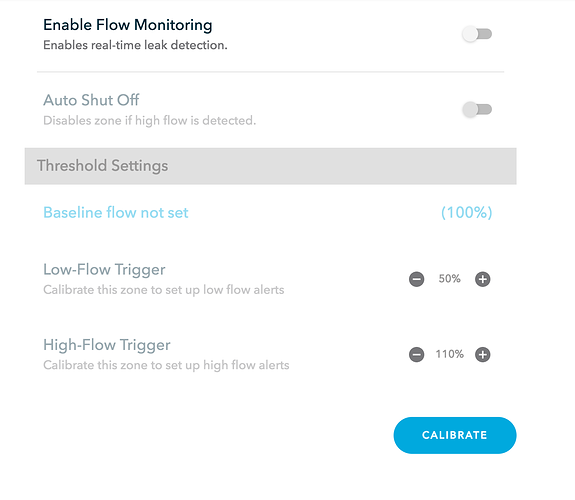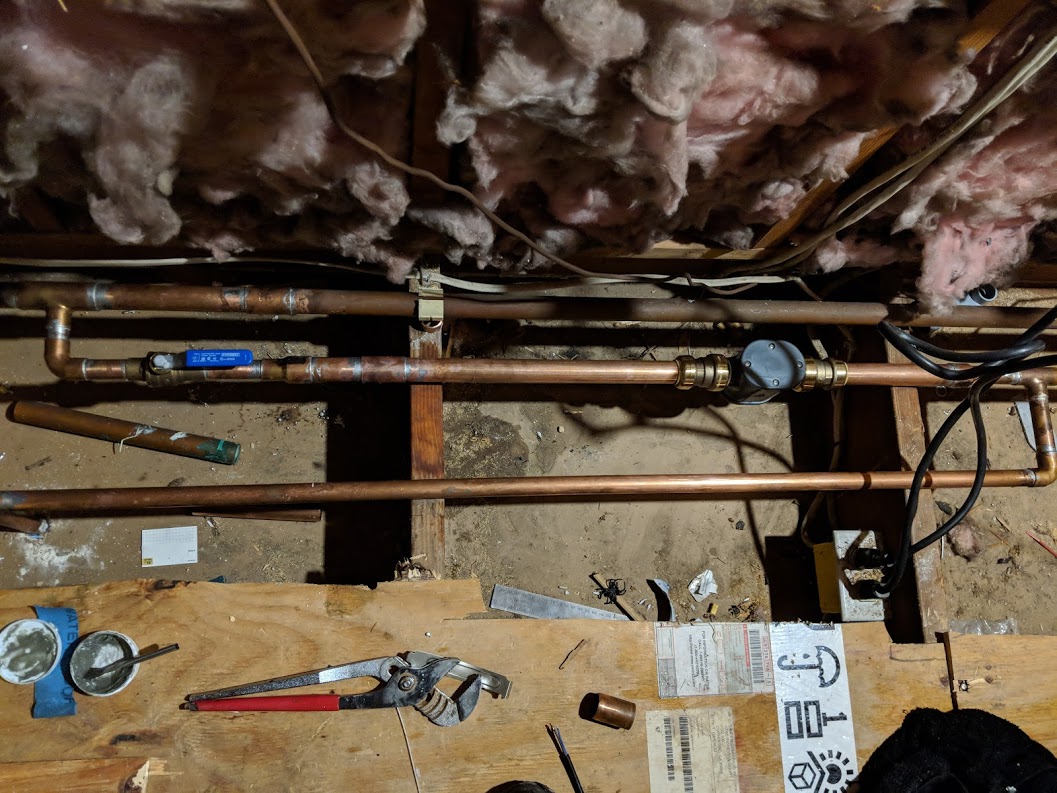Did something change with how the flow meter is calibrated?
I’m now seeing 0 water usage in all zones except one of my larger lawn spray zones? The front lawn always recorded ~180-200g of usage for a typical run, and now it shows 0. The other lower flow zones don’t seem to be working either.
That’s awesome that you got a flow meter installed!!!
I’ve looked at your account and it looks like you have great signal between your Flow Meter and R3 but your Flow Meter hasn’t been calibrated yet.
Once you’ve calibrated your Flow Meter, we will have a baseline to go off of and use that baseline to help get you your usages. Here’s a quick link that’ll help walk you through calibrating your Flow Meter and get you some data.
Let us know if you have any other questions or concerns.
Cheers 
Calibration is the key to getting the flow meter to be your best friend.
Just follow the aforementioned instruction and you will be on your way to keeping better track of your system.
I keep my low flow settings to @15% so that I may detect clogging nozzles in hard water conditions. That allows me to resolve the problem before it causes a decline in the landscapes that I oversee.
That’s very strange. I had calibrated when I installed it back in June when I received it. Is it typical for it to lose calibration? I have actual water usage for the month of July. It seems like the flow meter just stopped working properly in August.
I’ve tried recalibrating, but now many zones which were previous re-calibrated will no longer calibrate.
The zone “Rear Lawn - Patio”, for example, is a zone that have ~8 GPM of flow in the past, but now I can’t get it to calibrate. Its a zone with a bunch of typical lawn sprayers.
Did the calibration code change? I remember being told I should recalibrate at some point because the calibration code changed. I was previously able to calibrate all but one zone which has a handful of drippers. Now I’m able to calibrate only a single zone.  The rest report no flow.
The rest report no flow.
@tygunn I’m going to have our customer success team reach out to you tomorrow and determine next steps.

I had one unit do this to me earlier this month. I ended up deleting it, re-pairing and re-calibrating it.
The unit has not gone awry since.
On another note, are you using the same size pipe all the way from start to finish? I am just curious since none of my “Same size” installations have done this but it only happened on the one that I had to start with 3/4 inch copper to 1" copper, copper to PVC then back to copper on the other side of the flow meter.
My installation went from 3/4 to 1" and back to 3/4" again. I made sure that I had the minimum 6 inch of 1" prior to the WFM as the instructions recommend. I also found that a longer output tube from the WFM helps too.
How many GPH do you have on your drip system? Are you using plastic valves with flow control or Brass?
Are you using a drip filter/regulator combination or just a straight Sennenger regulator?
What is the TDS on your water hardness?
I’ll give a shot at re-pairing the flow meter tonight and see if that works, thanks.
I re-plumbed my irrigation lines in advance of getting the flow meter, also taking into account that I want to install a water softener in the future. I’ve got 1" coming into the house, and I chose to branch down to 3/4" for irrigation (almost everything in the ground is either 3/4" or 1/2" anyways). When it came time to install the flow meter I left 16" of 1" pipe on either side of the flow meter.
I’ve got a few drip zones right now. I’m not sure how much I trust the flow measured by the flow meter right now though. I’ve been meaning to use the water meter to test out the various drip loops and see how much they’re actually using. The drip zones I have for watering my citrus trees use large loops of 1/2" drip tubing with 0.6GPH drippers, but I’ve generally used 0.5 GPH drippers elsewhere.
My valves are all plastic with flow control. I use a filter/regulator combination after the valve for each drip zone and make sure to check the screens periodically.
My water is pretty hard 21 grains per gallon / 385 TDS. Its for this reason that I keep a pretty close eye on the system. Hard water scale has caused a few issues this season so far.
It sounds like you are doing everything correctly. The TDS should not be an impeding factor. I have run drip up to 450 parts per million before needing supplemental filtration.
It looks like re-pairing and calibration may help you out.
My mistake, the flow meter has only about 8" after it. But there is a good 20" of 1" pipe running up to the meter.
I wish I had just made the irrigation feed all 1" from the tee, but the 1" copper fittings are pretty pricey so I chose to minimize impact when installing the flow meter.
After the flow meter’s 8" run of 1" pipe, it reduces to 3/4" and then comes back to the left to feed the front of the house and then continues on to the back of the house off to the right.
@tygunn, can you elaborate on this? Are you getting a failure screen in the app during re-calibration?
We had a similar issue with a user that was resolved by removing the PEX Stiffner from the fitting – curious if you removed it before installation? If not, it’s not too late to remove it as it’s on the copper side of the fitting.
@emil, I’m seeing both an error that “no flow was detected”, and also occasionally I see the error:
"Oops! We couldn’t complete calibration.
Make sure your flow sensor is connected. Then, calibrate again."
I did not remove the pex stiffener. I’ll have to defer doing that until another time as it’ll require redoing a bunch of plumbing. There is not enough flex in the piping to be able to pull the sharkbit fitting off the copper pipe, so I’d have to cut the copper to be able to get the sharkbite off the copper.
I honestly wish there was a way to isolate the flow meter with unions so it could be pulled up out of the pipe run without pulling the pipes apart. I need to really think about that more.
Perhaps the “right” stack of fittings is:
3/4" to 1" copper transition (existing)
1" copper to 1" PVC sharkbite
1" PVC union
6" length of PVC pipe
1" PVC to 1" PVC push fitting
Flow meter
1" PVC to 1" PVC push fitting
length of PVC pipe
1" PVC to 1" copper sharkbite
existing 1" copper
Ugh. Its a mess, but at least I could pull out the flow meter in the future.
Shark bite has repair couplings. There is no stop in the middle like the standard ones.
Just leave a little more slide room for the fitting
Simply press the removal tool to loosen the Sharkbite, then slide the Sharkbite in the direction of the removal tool. Then you can remove the flow sensor with its removal tool for PVC Sharkbite.
Shark bite has repair couplings. There is no stop in the middle like the standard ones.
Just leave a little more slide room for the fitting
Simply press the removal tool to loosen the Sharkbite, then slide the Sharkbite in the direction of the removal tool. Then you can remove the flow sensor with its removal tool for PVC Sharkbite.
My issue is that fittings like sharkbites require you to pull the pipe out of the fitting. There is no give/flex in the plumbing run to be able to pull the copper out of the sharkbite. 1" and 3/4" copper is also so rigid I just don’t have enough side to side flex to help either.
Of course. You may need to have a couple more inches of pipe before or after the connections to the sensor.
As is, Rachio requires a minimum of 6 inches of straight pipe before the sensor. Some people actually put up to 16 in. In order to use the slip coupling from SharkBite, you need a minimum of 9in so that you are able to cut the pipe and properly reinsert the SharkBite slip coupling.
Of course. You may need to have a couple more inches of pipe before or after the connections to the sensor.
As is, Rachio requires a minimum of 6 inches of straight pipe before the sensor. Some people actually put up to 16 in. In order to use the slip coupling from SharkBite, you need a minimum of 9in so that you are able to cut the pipe and properly reinsert the SharkBite slip coupling.
I don’t know why this would all of a sudden be an issue. As I said before, I calibrated this after installation and was getting flow readings in all but 2 zones.
I just re-paired the flow meter and now it won’t calibrate any of the zones (Says no flow), and then after a couple of zones I get the “Oops! We couldn’t complete calibration. Make sure your flow sensor is connected. Then, calibrate again.” error once more.
My installation is well within spec per the instructions with greater than 6" of pipe on either side of the flow meter.
It seems my flow meter is now completely useless. I’ve disabled flow monitoring for all zones as I’m tired of getting “low flow” warnings.
Since I can’t get the flow meter to calibrate at all and there are no real solutions being offered, I am thinking I might just remove the flow meter and install something like this in my irrigation branch instead so I can monitor for leaks when the system is inactive and so I can characterize the actual volume of water being used:
Given that Rachio tracks hours of usage per zone, with a water meter like I linked above it would be pretty trivial for me to characterize the water flow for my zones and combine this with exported per-zone times.
Love the rachio controller; its unfortunate the flow meter didn’t pan out for me.
@tygunn I’m hoping I can provide a last effort towards getting the Flow meter to work for you. This is going to require some troubleshooting, so I want to make sure your good to go through the process.
- Can we make sure that the device is showing “Connected” with a good signal strength?
- What is your current Pressurization time? Is it 3 minutes or more?
- Please go to an individual zone, Flow Settings and Calibrate. Let’s see if a single zone can calibrate consistently.
Let’s see if we can find a solution by reducing the complexity. There might be something going on during the multi-zone calibration that is causing an issue.
- The flow meter shows as connected with “excellent” signal strength.
- Pressurization time was 3 minutes. I just tried 5 minutes.
- I tried calibrating one of my lawn zones. The first time it failed with the “Oops! We couldn’t complete calibration.
Make sure your flow sensor is connected. Then, calibrate again.”. Message. The second time it said no flow was detected.
Flow meter is in the garage attic (drywall ceiling, no random RF shielding in there). Controller is 20ft away in the garage hanging midway up the wall.
You seem to be having the same problem I have been having… After it “Fails” calibration do you show a calibrated value with the current date and time in the zone settings. It’s reading the flow, but portions of the software doesn’t think that it is…


